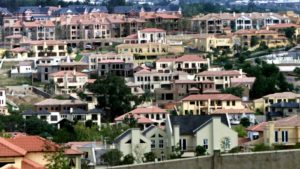
January 9, 2018//-In order to gain access to an unremarkable suburban road, South Africans have become accustomed to parting with their most personal details.
At barriers erected across public roads, people who want to cross into this protected zone fill in their name, surname, cellphone, identity and car registration numbers, and then the exact time of their entry.
The law says they don’t have to when driving on a public road, but most people don’t give a second thought to handing over data in exchange for a sense of personal security in a city like Johannesburg with a reputation for high contact crimes, like murder and robbery.
This payoff, however, has created pockets of development—ranging from middle class suburbia to opulence—walled off from South Africa’s socio-economic reality. It has not only exacerbated inequality by making those beyond the wall invisible, gated communities show how short South Africans’ memory is about restricting the movement of the disenfranchised.
Until the end of apartheid, South Africa’s suburbs were for whites only, policed by ironically named pass laws. Of course, the inhumanity of forcing black people to carry a pass and live under curfew is incomparable to filling out a security guard’s jotter, but the popularity of gated communities reveal urban South Africa’s inability to shake off some of the apartheid era’s security tactics.
The prevalence of gated communities may also reveal what South Africans think constitutes middle class life. As it did under apartheid, it often means avoiding the poor unless they are servants, nannies or gardeners. Instead of creating racial segregation, gated communities often broaden the economic gap in South Africa and restricts development to privatized progress.
Gated communities in Johannesburg and other parts of the city were created by neighborhood associations in the early 2000s who were trying to protect their blocks from violent crime. Going beyond neighborhood watch patrols, communities club together to fence off streets and erect a boom at a main thoroughfare, manned by a private security guard.The city has tried to regulate (pdf) the power of these community associations, but have no response to residents who rightfully accuse authorities of failing to prevent crime.
Despite early protests that these restrictions echoed apartheid-era security measures, they’ve continued to mushroom particularly in South Africa’s economic hub, the province of Gauteng. They’ve evolved to walled villages with rows of semi-detached townhouses or palatial free-standing homes and now represent 15% of the entire real estate market, according to property research company Lightstone.
Estates seem to be fenced off from South Africa’s economic downturn, with property prices within an estate costing three times as much as the national average, making them a safe investment. Still, Lightsone found that estate living has become more accessible as developers target first-time buyers through townhouse complexes that offer security and a shared barbecue area.
Increasingly, estates offer compact urban environments to their residents whose interaction with the chaos of life on the other side of the wall is decreased. In Johannesburg, depending on the price, they offer something of a fantasy respite removed from the city’s grit. Residents have a choice of a golf estate overlooking lakes, equestrian estates with private stables or eco-estates that incorporate mini nature reserves and live game. One of the most expensive, Cloud’s End in Sandton, Johannesburg, has a median property value of 18.2 million rand ($1.5 million).
“Estates also enable residents greater control over the development of their community and facilities, finances and ultimately enable greater control over their social and physical environment and a high degree of independence in running their affairs,” an agent for a high-end realtor told South African finance site Fin24.
At the very least estates offer internal parks and playgrounds. Who can blame young families for opting to raise their children in an estate when anyone who’s walked through some of Johannesburg’s parks knows the city is struggling to maintain basic safety, much less swings and slides. As state institutions flounder, estate living has gone on to offer attached private schools and clinics. The most brazenly ambitious development so far has been Steyn City, a self-contained community named for its developer billionaire businessman Douw Steyn.
Privatized amenities in gated communities mean citizens don’t have to hold the city accountable, which is a shame because these are the citizens who often have the power to pressure the city to do better.
Public education and healthcare are increasingly the problem of the poor, while South Africans who can afford it pay for the chains of private clinics and schools that have become as ubiquitous as the gated communities. To South Africans so recently forced to endure separate amenities at the expense of the poor black majority during apartheid, it’s a little surprising that they’ve allowed the walls to come up so high, so quickly.
qz.com


